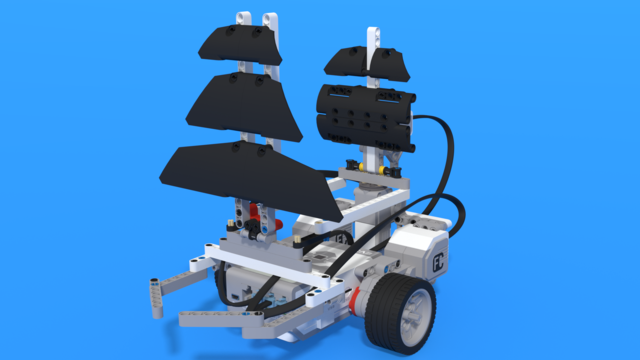
To access the full video please subscribe to FLLCasts.com
- #1201
- 12 Apr 2019
It would be helpful for this class if you have a field - black line that plays the role of a shore.
You could find example solution to the program here:
https://www.fllcasts.com/programs/lpsxim-program-for-the-ev3-pedalo-robot-gen
The first 2 tasks are designed to help students program the robot move forward. Because of the strange shape of the pedalo wheel and because of the small differences in the LEGO Mindstorms Motors the robot could turn slightly to one side. In one of our classes we set the values for turning to "-12" and in this way made the robot more forward. But expect different values for different robots. The position of the fins generally does not matter as the wheels are turned with different speed.
The third task is designed to demonstrate to students how difficult it is to make this robot turn 90 degrees when the motors are programed with rotations. If you plan to personally explain the Gyro sensor to them, then use the time they are trying to make it turn to 90 degrees and get all the students reach this tasks. Even the slower once. Make sure all the students have tried to make the robot turn at least once.
After that you move the Gyro sensor (the new sensor). There are two tasks - to measure 90 degrees and to cause a "gyro drift" of the sensor. This happens when you push the cable while rotating the sensor. After that they must do 3 rotations forward. The blocks should be configured as the first or the robot could turn.
Then comes the difficult part where students must program the robot to turn 60 degrees. Most probably all the students will fail the first time. The key part here is that they should turn the robot to 60 degrees after it has turn to 90 degrees. Because the robot has already turned to 90 degrees and we want to turn to 60 more degrees we must program the robot to turn until the degrees of turning are equal to at least 90+60=150 degrees.
After that there is additional 1 rotation forward. In the same way you must configure it move forward. The next task requires 50 degrees back. This is similar to the previous task, but instead of adding them, we are subtracting them and get 150-50=100 degrees. At the end we have 2 rotations forward.
If you are wondering why the power settings of the motors are so low, you can explain to students that the faster the robot move, the more noise it would make and will scare the fish. Also, despite the Gyro sensor if the robot is moving to fast it can not precisely turn.

Courses and lessons with this Tutorial
This Tutorial is used in the following courses and lessons

Level D2. "Seafaring". Robotics with LEGO
The eighth level of the Robotics with LEGO curriculum for students in third or fourth grade.
In this level, students learn to use the fourth sensor in the robotics set - the gyro sensor. The robots are modeled after boats, yachts, and ships. With the help of the gyro sensor, students can set a course for their robots to a given angle and can detect deviations from the course. In open seas, there may be sea-monsters and the robots are being programmed to detect a sudden change in acceleration with the help of the said sensor.
- 24
- 2:49
- 107

Lesson 1 - Pedalo for fishing
Introduction
Today we would build a pedalo for fishing. Have you event been on a pedalo? Have you see pedalos? Where?

Do you know that motor boats are not allowed in lakes and dams as they disrupt the animals. That's why today we are going fishing with a Pedalo.
Finishing boats and pedalos for fishing use an device called sonar, to detect large groups of fish. Our pedalo would use exactly such device to detect the group of fish and catch up with it.
- 4
- 4
- 10
- 3d_rotation 1